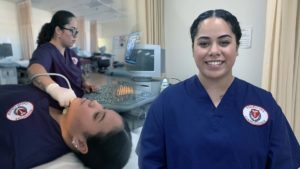Become an Ultrasound Technician
Starting a career path to be an ultrasound technician can be confusing. There are many options available, and you may not know what to look for. However, the biggest obstacle is simply starting. The best way to find out more about the career is to visit schools in person. That way, you can get a feel for the campus and find out whether it’s a good fit for you. Once you’re at the school, it would be a good idea to ask the right questions so that you can compare the important features. Three key components of a school are: admissions, accreditation, and board exams.
Admissions
The first step to enroll into an ultrasound technician program is to meet with an admissions representative at your school of interest. When you meet with an admissions representative, they will explain your curriculum, length of the program, and any prerequisites they may require as part of the enrollment process. Some institutions may require previous completed credits in specific classes, while others may only require a high school diploma. Once you’ve completed your enrollment process you will need to meet with a financial aid advisor to discuss any tuition you may be required to pay throughout the duration of your program. Depending on your financial situation, you might qualify for federal aid and student loans. Once you’ve completed these steps, you are ready to enroll.
Accreditation
Many programs vary depending on their accreditation, so let’s touch on what that means and why it’s important. There are many accreditation agencies available, and one is not necessarily better than the other. For example, the Commission on Accreditation of Allied Health Education Programs (CAAHEP) is a major accreditation agency for sonography programs. Many schools which are accredited by CAAHEP require students to take prerequisites prior to enrolling in the program, and program requirements may be longer. The trade-off for these longer requirements is that students from a CAAHEP accredited school may sit for the Association of Registered Diagnostic Medical Sonographers (ARDMS) board exam right away. There are two components to the ARDMS board exam: the SPI exam and a specialty exam. If your school is not accredited by CAAHEP, you can still take the Sonography Principles and Instrumentation (SPI) exam while you’re in school. However, in order to take the specialty exam to be fully certified, you will be required to work as an ultrasound technician for one year after graduation before you can become eligible to be fully ARDMS certified. Usually, clinics and imaging centers will not need employees to be fully certified, while hospitals will require employees to be certified. In order to get certified, you have your choice of two certifying bodies: the ARDMS and the American Registry of Radiologic Technologists (ARRT). If you obtain an Associate’s Degree along with completing an ultrasound technician program you can sit for the ARRT board exam. This is another option to become registered without the required one year of work history as an ultrasound technician right after graduation.
Board Exams
To become a registered Ultrasound Technician you will need to take a physics exam called the Sonography Principles and Instrumentation (SPI), along with an ARDMS specialty exam of your choosing within five years. The SPI examination for the ultrasound technician credentials is two hours long, including a five-minute survey, and contains approximately 110 multiple-choice and Semi-interactive Console questions (source: https://www.ardms.org/get-certified/spi/). In regards to your specialty board exams, their format will be identical; the examinations are three hours long, including a five-minute survey, and contains approximately 170 multiple-choice questions (source: https://www.ardms.org/get-certified/rdms). Many facilities will hire candidates who have passed the SPI, in anticipation that they will pass the specialty exam after one year of employment. Besides the ARDMS, candidates also have the option to get certified through the American Registry of Radiologic Technologists (ARRT). To sit for the ARRT, you need to have completed an ultrasound technician certificate program, as well as earn an Associate Degree. The Associate Degree can be in any field. The ARRT consists of just one exam, and those with an Associate Degree do not need to wait for one year of employment before taking the exam.



